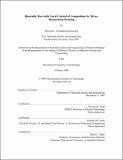Bimetallic bars with local control of composition by three-dimensional printing
Author(s)
Techapiesancharoenkij, Ratchatee, 1979-
DownloadFull printable version (1.906Mb)
Other Contributors
Massachusetts Institute of Technology. Dept. of Materials Science and Engineering.
Advisor
Samuel M. Allen and Emanuel M. Sachs.
Terms of use
Metadata
Show full item recordAbstract
Three Dimensional Printing (3DP) is a process that enables the fabrication of geometrically complex parts directly from computer-aided design (CAD) models. The success of 3DP as an alternative manufacturing technology to bulk machining of materials for complex parts has been demonstrated. By proof of concept, 3DP has demonstrated the ability to create parts with Local Control of the Composition (LCC). LCC allows tailoring the material properties in regions of a part for functional purposes. In this work, LCC was studied and demonstrated by fabricating bimetallic bars consisting of two layers of Fe-Ni alloys with different composition and, hence, different thermal expansion properties; the coefficient of thermal expansion (CTE) of Fe-Ni system is sensitive to its composition. Two types of the binder/dopant slurries were made for making the LCC bars. One type consisted of dispersions of Fe₂O₃ particles in water, and the other consisted of dispersion of NiO in water. The LCC bars were successfully made by printing the Fe₂O₃/NiO slurries into Fe-30Ni base powders. After heat treatment to impart strength to the printed bars, the bars were successfully retrieved from unbound powders. The bars, then, were annealed at 1400 ⁰C for 2 hours for sintering and homogenization. The final composition of the base powders were changed accordingly. In the layers on which an Fe₂O₃ slurry was printed, the Fe composition of the layers increased on average to 72wt%. Similarly, the Ni composition of the Ni-enriched layers of the bars increased on average to 33wt%. The densification and local homogenization resulting from reduction and sintering treatments were not satisfactory. (cont.) The major problem was presumably caused by the oxide residues. The presence of the oxide powders was evident from the microprobe measurement. The oxide residues caused the local compositions to be inhomogeneous. As a result, the compositional profiles showed considerable scatter. Moreover, the residues impeded the sintering rate of the bars; the sintering densities of the bars were as small as 78% of the theoretical density. The resulting bimetallic bars did exhibit bending deflection on uniform heating. However, the bending deflections were much smaller than expected. Evidently, the compositional profiles of the bars critically influence their thermal bending properties. The scatter in the compositional profiles resulted in local variations of CTE in the bars, which degraded the thermal bending properties. A linear elastic model that allows prediction of the deflection as a function of composition profile shows good agreement with the observed deflections in the bimetallic bars with LCC.
Description
Thesis (S.M.)--Massachusetts Institute of Technology, Dept. of Materials Science and Engineering, 2004. Includes bibliographical references (p. 106-107). This electronic version was submitted by the student author. The certified thesis is available in the Institute Archives and Special Collections.
Date issued
2004Department
Massachusetts Institute of Technology. Department of Materials Science and EngineeringPublisher
Massachusetts Institute of Technology
Keywords
Materials Science and Engineering.